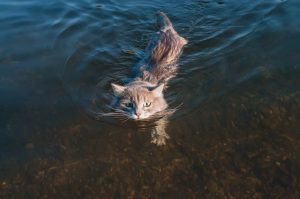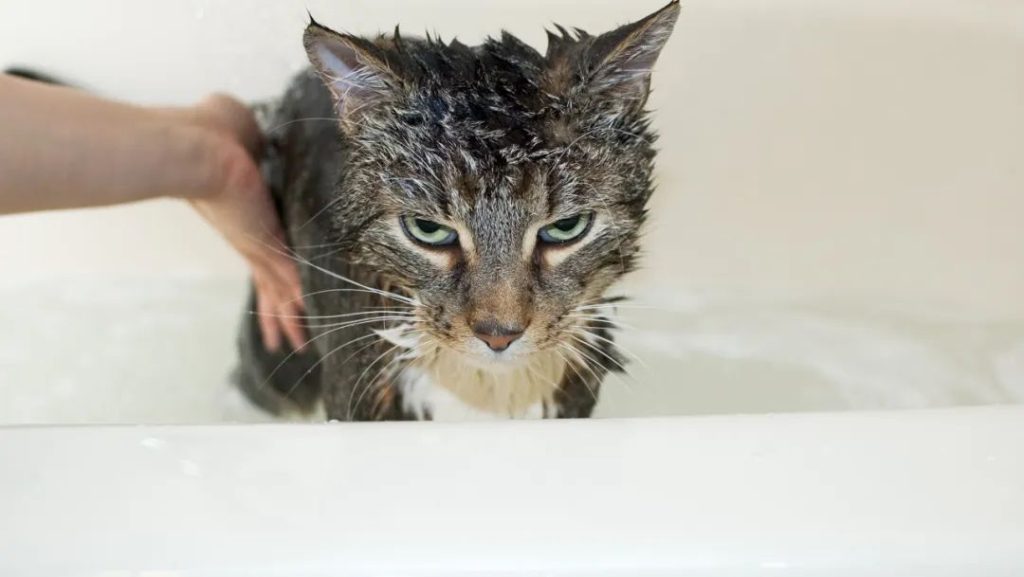Summer is here, and you want to give your cat a nice bath, but, as expected, the situation quickly spirals out of control. The cat is stressed, and so are you. You just want your cat to be soft and smelling fresh—so why does it scream like you’re torturing it? Is it really impossible to bathe a cat? Why is bathing so terrifying for them?
-
Fear of Water is Written in Their DNA
Unlike dogs, domestic cats haven’t completely lost their wild instincts during their domestication process. Their physical traits and behaviors are very similar to those of their wildcat ancestors. If we trace the evolutionary history of domestic cats, we’ll find that their dislike of water is actually embedded in their DNA. Modern genetic analysis shows that the DNA of domestic cats worldwide is nearly identical to that of the African wildcat. It can be inferred that these nocturnal hunters, who inhabited grasslands, deserts, or scrublands, are the ancestors of domestic cats. The African wildcat lives in dry environments with few opportunities to encounter large bodies of water, so swimming was not a necessary skill for hunting. They can obtain the water they need from their prey and have strong kidneys to prevent dehydration. Additionally, large carnivores that frequent water sources have further diminished their interest in swimming. This indifference to water, even wariness, has been passed down to domestic cats.On the other hand, cats’ fear of water is not just an evolutionary behavior; it also relates to their fluffy fur. Most cats’ fur is not waterproof. Under a microscope, you’ll see that the fur is covered with overlapping scale-like layers. Generally speaking, the smaller the angle between the scale layers and water droplets, the more easily the fur becomes saturated. The scale layers on a cat’s fur have a wavy structure, which makes the angle between the scales and water droplets often less than 90 degrees. In contrast to mink fur, which has long, finger-like structures and is more waterproof, a cat’s fur doesn’t handle water well. Once soaked, every hair could become drenched, and the heavy wet fur not only discomforts the cat but also makes it harder to move and balance. Moreover, a cat’s fur plays a key role in regulating body temperature. The insulating effect of fur is achieved through the air trapped between the hairs. The scale layers increase the gaps between the hairs, storing a lot of air, which slows the movement of air and heat exchange. Once the fur gets wet, the cat loses its insulating air layer and continues to lose heat through the evaporation of water. The physiological experience of a cat taking a bath is similar to you wearing a whole set of water-absorbing woolen clothes and jumping into a pool—uncomfortable and cold. It’s not a pleasant experience by any means.So, how do cats keep themselves clean?

-
Cats Groom by Spreading Oil
First of all, a cat’s idea of “clean” differs from ours. Cats have sweat glands only on their paw pads; they don’t sweat from their bodies but rather secrete oil. And for cats, oil is not “dirty.” On the contrary, it helps to lubricate their fur and offers good protection, sometimes even repelling light rain. That’s why when cats lick their fur, they are not removing oil but rather stimulating their sebaceous glands to spread oil evenly across their coat. The primary things cats need to clean are the dust and parasites that stick to their fur, but most importantly, they aim to eliminate odors. As ambush hunters, their instinct is to remove any scent that might alert their prey. And this is where their tongue comes in—nature’s built-in bathing tool. Anyone who has been licked by a cat will remember the sandpaper-like texture of their tongue. The surface of a cat’s tongue is covered with backward-facing barbs made of keratin, the same material found in human nails. Under a microscope, these hooked barbs appear like a curved structure, similar to a shoehorn. Their function combines combing, cleaning, and massaging, making it very efficient. The direction of the barbs isn’t fixed—when the tongue encounters a matted clump of fur, the barbs rotate and work their way deep into the knot, loosening it. The flexible barbs can clean not only the longer, sparser outer fur but also reach the skin and the shorter undercoat. Additionally, the curved structure of the barbs helps them absorb saliva using surface tension, spreading it over the cat’s body like a natural shampoo. In one day, a cat can transfer 48 milliliters of saliva to its coat. That’s equivalent to about a bottle of regular bottled water every ten days. So, when you bathe your cat, you’re not only washing away all the oil it has worked so hard to build up, but you might also be coating it with scents that you find pleasant but are irritating to the cat. From the cat’s perspective, you’ve just increased its cleaning workload.
-
Don’t Bathe Your Cat Unless Absolutely Necessary
Among the vast family of cats, there are exceptions. Some breeds, like the Bengal cat, which resembles a little leopard, remain completely still during baths and even play in water like little water monkeys. Anyone who sees this would probably exclaim, “That’s not a real cat, is it?” Moreover, just like how some people love bungee jumping despite the fear of heights, certain cats, while not naturally water-loving breeds, can still calmly interact with water. These brave cats often started their water-exploration journey early on in life. If a cat is exposed to water during kittenhood, it tends to be more accepting of it than if introduced to water as an adult. These cats are better equipped to handle the sensation of being surrounded by liquid. In fact, like most mammals, with the help of their whiskers, cats can swim without formal training—though most cats, like the one at your home, simply don’t want to.Considering the nature of most cats, veterinarians often advise against bathing them. However, in some situations, a bath is necessary. For instance, if your cat is too overweight or has arthritis and can’t reach certain areas to groom, or if it has ringworm and needs a medicated bath. In these cases, before you start preparing your cat’s “bath tools,” make sure you understand your cat’s sensitive areas. Cats are highly sensitive to sound and smell. Beyond the water itself, the scent of shampoo, the sound of the showerhead, and the blow dryer can make a cat uneasy. Cats also prefer having control over their environment. They might enjoy playing with water at the sink or in a fish tank, where they can escape whenever they want. But when they’re in a slippery bathtub or a strange pet spa bath with water all over them, it feels like they’re completely at your mercy. In such a scenario, a cat’s sense of security may vanish faster than its fur can shed.
So, to bathe your cat properly, the most important thing is to be as prepared as possible and have endless patience, ensuring that your cat feels comfortable and safe. However, if there’s no urgent need for a bath and your cat is truly reluctant, it’s best not to force it. Let your cat stay clean and beautiful according to its own standards—with a shiny, healthy coat that’s naturally well-maintained.





